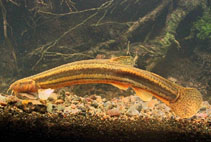Загрузить свой Фото и Видео
Pictures | Изображение на GoogleMisgurnus fossilis
Picture by Tveskov, E.
Pictures | Изображение на GoogleMisgurnus fossilis
Picture by Tveskov, E.
Ukraine country information
Common names:
Viun
Occurrence: native
Salinity: freshwater
Abundance: | Ref:
Importance: | Ref:
Aquaculture: | Ref:
Regulations: | Ref:
Uses: no uses
Comments:
National Checklist:
Country Information: https://www.cia.gov/library/publications/resources/the-world-factbook/geos/up.html
National Fisheries Authority:
Occurrences: Occurrences Point map
Main Ref: Movchan, Y.V., 1988
National Database:
Occurrence: native
Salinity: freshwater
Abundance: | Ref:
Importance: | Ref:
Aquaculture: | Ref:
Regulations: | Ref:
Uses: no uses
Comments:
National Checklist:
Country Information: https://www.cia.gov/library/publications/resources/the-world-factbook/geos/up.html
National Fisheries Authority:
Occurrences: Occurrences Point map
Main Ref: Movchan, Y.V., 1988
National Database:
Common names from other countries
Классификация / Names народные названия | синонимы | Catalog of Fishes(род, виды) | ITIS | CoL | WoRMS | Cloffa
Environment: milieu / climate zone / depth range / distribution range экология
; пресноводный; солоноватоводный демерсальный; мигрирует в реке (Ref. 51243). Temperate; 4°C - 25°C (Ref. 1672); 62°N - 42°N, 15°E - 61°E
распространение страны | регионы FAO | Ecosystems | места находок | Point map | интродукции | Faunafri
Europe and Asia: In Europe, north of the Alps, from Meuse eastward to Neva drainages and Lake Ladoga; northern Black Sea basin from Danube eastward to Kuban, absent on the southern section; Caspian basin in Volga and Ural drainages. Not native to Great Britain, Scandinavia, Apennine and Iberian peninsulas, Crimea, and Adriatic, Aegean and White Sea basins. Locally introduced in Rhône drainage (France) and perhaps elsewhere (Ref. 59043).
Length at first maturity / Size / Вес / Возраст
Maturity: Lm ?, range 11 - ? cm
Max length : 30.0 cm TL самец/пол неопределен; (Ref. 556); 30.7 cm TL (female); common length : 15.0 cm TL самец/пол неопределен; (Ref. 556)
Max length : 30.0 cm TL самец/пол неопределен; (Ref. 556); 30.7 cm TL (female); common length : 15.0 cm TL самец/пол неопределен; (Ref. 556)
Краткое описание определительные ключи | морфология | морфометрия
колючие лучи спинного плавника (общее число) : 3; членистые (мягкие) лучи спинного плавника (общее число) : 5 - 6; колючие лучи анального плавника: 3; членистые (мягкие) лучи анального плавника: 8 - 11; позвонки: 49 - 50. Broad midlateral stripe from eye to caudal base and narrow stripe from opercle at least to pelvic origin. Lamina circularis absent in males (Ref. 59043). Caudal fin with 14-16 rays (Ref. 40476).
Facultative air-breathing (Ref. 126274); Found in lower reaches of slow-flowing rivers, but can also be found in still pools (Ref. 9696), on sandy bottoms of ponds, pools and ditches. Adults are nocturnal which burrow into mud during dry periods and strong frosts. Usually, burrows are 20-30 cm deep, occasionally down to 70 cm during dry periods (Ref. 59043). During the day, they stay buried in the sand. Feed on insect larvae and small mollusks. Seldom captured with hook and line (Ref. 30578). Are sensitive to pollutants which accumulate in the sediment (Ref. 11941). Facultative air-breathers (Ref. 27368). A female specimen measuring 30.7 cm TL was recorded from Netherlands (Ref. 114650).
Life cycle and mating behavior половая зрелость | размножение | нерест | икра | Fecundity | личинки
Male follows female into dense vegetation and forms a complete ring around her body, behind dorsal fin (Ref. 59043).
Основная ссылка
Upload your references | ссылки | координатор | соавторы
Kottelat, M. and J. Freyhof, 2007. Handbook of European freshwater fishes. Publications Kottelat, Cornol and Freyhof, Berlin. 646 pp. (Ref. 59043)
Статус Красного Списка МСОП (Ref. 130435: Version 2024-2)
Не вызывающий беспокойства (LC) ; Date assessed: 16 January 2023
Угроза для людей
Harmless
Использование человеком
рыболовство: интереса не представляет; наживка: usually
FAO(рыболовство: production; publication : search) | FishSource |
дополнительная информация
Population dynamics
Growth parameters
Max. ages / sizes
Length-weight rel.
Length-length rel.
Размерный состав
Mass conversion
пополнение
численность
Growth parameters
Max. ages / sizes
Length-weight rel.
Length-length rel.
Размерный состав
Mass conversion
пополнение
численность
Life cycle
размножение
половая зрелость
Fecundity
нерест
Spawning aggregations
икра
Развитие икры
личинки
динамика численности личинок
размножение
половая зрелость
Fecundity
нерест
Spawning aggregations
икра
Развитие икры
личинки
динамика численности личинок
Physiology
Body composition
Nutrients
Oxygen consumption
Swimming type
Swimming speed
Visual pigments
Fish sound
Diseases & Parasites
Toxicity (LC50s)
Body composition
Nutrients
Oxygen consumption
Swimming type
Swimming speed
Visual pigments
Fish sound
Diseases & Parasites
Toxicity (LC50s)
Human related
Aquaculture systems
особенности рыбоводства
степень растяжения
Ciguatera cases
Stamps, coins, misc.
Aquaculture systems
особенности рыбоводства
степень растяжения
Ciguatera cases
Stamps, coins, misc.
инструменты
Bio-Quiz | E-book | полевой определитель | Длина-Частота | онтогенез | карта точек | Classification Tree
| Catch-MSY |
Специальные отчеты
Проверить содержание в аквариумах | Проверить опубликованные видовые данные | Проверить опубликованные данные по аквакультуре
Скачать в формате XML
ресурсы в Интернет
Alien/Invasive Species database | Aquatic Commons | BHL | Cloffa | Websites from users | Проверить FishWatcher | CISTI | Catalog of Fishes(род, виды) | DiscoverLife | ECOTOX | Faunafri | Fishtrace | GenBank(Геном, Нуклеотид) | GloBI | GOBASE | | Google Books | Google Scholar | Google | IGFA World Record | MitoFish | национальные базы данных | Otolith Atlas of Taiwan Fishes | общественные аквариумы | PubMed | Reef Life Survey | Scirus | SeaLifeBase | Tree of Life | Wikipedia(Вперёд, поиск) | World Records Freshwater Fishing | Zoological Record
Estimates based on models
Phylogenetic diversity index (Ref. 82804): PD50 = 0.5039 [Uniqueness, from 0.5 = low to 2.0 = high].
Bayesian length-weight: a=0.00417 (0.00228 - 0.00763), b=3.10 (2.94 - 3.26), in cm Total Length, based on LWR estimates for this species & (Sub)family-body (Ref. 93245).
Trophic level (Ref. 69278): 3.4 ±0.45 se; based on food items.
устойчивость к внешним воздействиям (Ref. 120179): средний (среднего размера), минимальное время удвоения популяции 1.4-4.4 года (tm=2; Fec=100,000-150,000).
Fishing Vulnerability (Ref. 59153): Low vulnerability (21 of 100).




